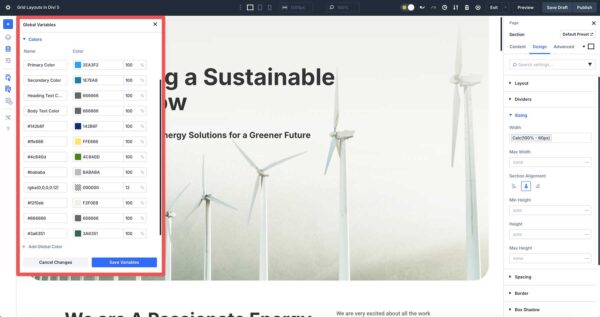Summer is here, and designers are buzzing about the upcoming Apple release, design changes, and trends that are coming with it. The biggest being a glass effect. You’ll see some new tools for designers in this roundup that reflect that… Continue Reading →
CSS variables are like reusable design ingredients. You define them once, as your brand colors, font sizes, or spacing, and then use them wherever needed. They save you from typing the same hex codes and pixel values across different sections…. Continue Reading →
Rounded corners didn’t just win—they staged a quiet coup and made our interfaces soft, friendly, and suspiciously comforting. This satirical love-hate letter to border-radius explores how we went from brutalist boxes to UI that feels like a therapy session. If… Continue Reading →
Web design is all about creating consistent, scalable websites with less effort. Design Variables can transform how designers work across multiple web design tools, from Figma to our own Divi. In this post, we’ll explore how variables streamline workflows, ensure… Continue Reading →
If you often just obsessively nudge pixels until your sanity starts to fray… This painfully relatable (and slightly unhinged) journey through the 7 stages of pushing pixels is for you! If you’ve ever cried over a 0.5px misalignment, this one’s… Continue Reading →
The web isn’t dying because of AI—it’s drowning in a sea of templates. Platforms like Squarespace, Wix, and Shopify have made building a site easier than ever—but at the cost of creativity, originality, and soul. If every website looks the… Continue Reading →
Looking to add some slick features to your WordPress site but don’t want to wrestle code? Good news! That’s where shortcodes come in, little gems like or [contact-form] tucked in square brackets. These simple bracketed commands enable site owners to… Continue Reading →
Hero images are the web’s prettiest dead weight—slow, vague, and visually overused. It’s time to stop decorating your homepage and start saying something that actually matters.
Have you ever wanted to tweak your WordPress site just a bit, like change a button’s color or adjust a page’s layout? WordPress is great for building sites without coding, thanks to its easy dashboard and endless themes and plugins…. Continue Reading →
Tired of watching the loading spinner do its little dance of despair? This brutally honest breakup letter to everyone’s least favorite UI element calls out the lies, the stalling, and the silent screams behind every infinite loop. If you’ve ever… Continue Reading →
The next evolution of web design isn’t about looks — it’s about knowing you better than you know yourself. Get ready for a future where websites don’t just personalize your experience — they profile your soul in real-time. Creepy? Absolutely…. Continue Reading →
Another month, another roundup packed with design tools that use artificial intelligence features to supercharge your workflows.
Apple just resurrected skeuomorphism, but it’s hiding behind shiny buzzwords like “Liquid Glass.” Is this a stunning reinvention of UI or a glossy distraction from Siri’s ongoing failure? Either way, Apple’s new design looks incredible… until you try to read… Continue Reading →
Websites are about to start designing themselves—literally. Powered by AI and real-time behavior data, they’ll adapt layouts, copy, and UX on the fly. What does that mean for web designers? Obsolescence… unless we evolve fast.
Your landing page doesn’t need more fluff—it needs receipts. **SocialProofExamples.com** is the ultimate swipe file of real, high-impact trust signals used by companies like Notion, Webflow, and Zapier. If your testimonials still sound like they were written in 2013, it’s… Continue Reading →
Your website’s design is more than just a pretty face, it’s the handshake that greets every visitor. These days users decide in seconds whether to stay or bounce, good design isn’t optional. Calmer color palettes (soft pastels, muted earth tones,… Continue Reading →
AI agents aren’t coming—they’re already quietly transforming how designers, developers, and UX pros work every day. From building layouts to debugging code and synthesizing user feedback, they’re the digital sidekicks doing the busywork so you can focus on the big… Continue Reading →
It seems like artificial intelligence is at the core of almost every conversation in design, media, and marketing. That is obvious with the release of new design tools as well. There are AI-influenced elements everywhere. So in this list, you… Continue Reading →
In a world dominated by cancel culture, web designers are finding it harder to think outside the box without facing backlash or professional consequences. While creativity may feel stifled, it’s possible to still push boundaries responsibly by balancing bold ideas… Continue Reading →
Getting started with building Gutenberg blocks and Gutenberg apps can feel like climbing a steep hill — and you’re not alone in thinking that. One of the biggest challenges in Gutenberg development is setting up the development environment. From installing… Continue Reading →
For the majority of agencies, Elementor Pro has long been the answer. It’s a speedy and visual way to build stunning WordPress sites with no code or little code, and it’s a simple sell to clients who want the advantages… Continue Reading →
Success in any field relies on time-tested rules of thumb. These simple yet powerful principles help us make smart decisions efficiently. In the world of WordPress, following proven guidelines can mean the difference between a slow, underperforming site and a… Continue Reading →








